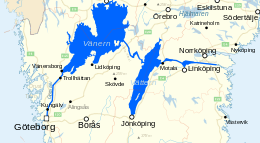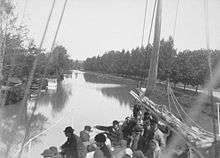Göta Canal
Coordinates: 58°29′54″N 16°10′24″E / 58.49827°N 16.17332°E

The Göta Canal (Swedish: Göta kanal) is a Swedish canal constructed in the early 19th century. It formed the backbone of a waterway stretching some 614 km (382 mi), linking a number of lakes and rivers to provide a route from Gothenburg on the west coast to Söderköping on the Baltic Sea via the river Göta älv and the Trollhätte kanal, through the large lakes Vänern and Vättern.
The canal itself is 190 km (120 mi) long, of which 87 km (54 mi) were dug or blasted, with a width varying between 7–14 m (23–46 ft) and a maximum depth of about 3 m (9.8 ft).[1] It has 58 locks and can accommodate vessels up to 32 m (105 ft) long, 7 m (23 ft) wide and 2.8 m (9.2 ft) in draft.[2] Göta Canal is a sister canal of Caledonian Canal in Scotland, which was also constructed by Thomas Telford.
History
The idea of a canal across southern Sweden was first put forward as early as 1516, by Hans Brask, the bishop of Linköping. However, it was not until the start of the 19th century that Brask's proposals were put into action by Baltzar von Platen, a German-born former officer in the Swedish Navy. He organised the project and obtained the necessary financial and political backing. His plans attracted the enthusiastic backing of the government and the new king, Charles XIII, who saw the canal as a way of kick-starting the modernisation of Sweden.[3] Von Platen himself extolled the modernising virtues of the canal in 1806, claiming that mining, agriculture and other industries would benefit from "a navigation way through the country."[4]
The project was inaugurated on 11 April 1810 with a budget of 24 million Swedish riksdalers.[5] It was by far the greatest civil engineering project ever undertaken in Sweden up to that time, taking 22 years of effort by more than 58,000 workers. Much of the expertise and equipment had to be acquired from abroad, notably from Britain, whose canal system was the most advanced in the world at that time. The Scottish civil engineer Thomas Telford developed the initial plans for the canal and travelled to Sweden in 1810 to oversee some of the early work on the route. Many other British engineers and craftsmen were imported to assist with the project, along with significant quantities of equipment - even apparently mundane items such as pickaxes, spades and wheelbarrows.[1]
The Göta Canal was officially opened on 26 September 1832 in an event commemorated by the painter Johan Christian Berger in his work The Opening of the Göta Canal on 26 September 1832. Von Platen himself did not live to see the completion of the canal, having died shortly before its opening. However, it was never an economic success. The arrival of the railways in 1855 quickly made it redundant, as trains could carry passengers and goods far more rapidly and did not have to shut down with the arrival of winter, which made the canal impassable for five months of the year.[6] By the 1870s, the canal's goods traffic had dwindled to just three major types of bulk goods - forest products, coal and ore, none of which required rapid transportation. Traffic volumes stagnated after that and never recovered.[1]

Bishop Hans Brask's original justifications for the canal's construction were the onerous Sound Dues imposed by Denmark–Norway on all vessels passing through the narrow Øresund channel between Sweden and Denmark and the trouble with the Hanseatic League. The canal enabled vessels travelling to or from the Baltic Sea to bypass the Øresund and so evade the Danish toll.[7] In 1851, the tycoon André Oscar Wallenberg founded the Company for Swedish Canal Steamboat Transit Traffic to carry goods from England to Russia via the canal. However, it only ran two trips between St Petersburg and Hull via Motala before the Crimean War halted Anglo-Russian trade. After the war ended, the great powers pressured Denmark into ending the four-hundred-year-old tradition of the Sound Dues, thus eliminating at a stroke the canal's usefulness as an alternative to the Øresund.[8]
The canal had one major industrial legacy in the shape of Motala Verkstad - a factory established in Motala to produce the machines such as cranes and steam dredgers that were needed to build the canal. This facility has sometimes been referred to as the "cradle of the Swedish engineering industry". After the canal was opened, Motala Verkstad focused on producing equipment, locomotives and rolling stock for the newly constructed railways, beginning a tradition of railway engineering that continues to this day in the form of AB Svenska Järnvägsverkstädernas Aeroplanavdelning (ASJA) that was bought by the aeroplane manufacturer SAAB in Linköping.[1][9]
Trollhätte Canal
The Trollhätte Canal (Swedish: Trollhätte kanal) is a canal in Sweden that is now part of the Göta Canal. It connects the Göta älv river with Lake Vänern.

Ships classified as Vänermax are of the maximum dimensions that will fit through the canal. The maximum dimensions for a boat to traverse this canal are:
- Length: 88 m
- Width: 13.20 m
- Mast height: 27 m
- Depth: 5.40 m
Modern usage
Parts of the canal are still used to transport cargo, but it is now primarily used as a tourist and recreational attraction, dubbed Sveriges blå band ("Sweden's Blue Ribbon"). Around two million people visit the canal each year on pleasure cruises - either on own boats or on one of the many cruise ships - and related activities.[1] The canal is ironically referred to as the "divorce ditch" from the troubles that couples have to endure while trying to navigate the narrow canal and the many locks by themselves.
Locks
From the east-coast of Sweden to Lake Vänern the locks are as follows: (with meters per locks)
- Mem, 3
- Tegelbruket, 2.3
- Söderköping, 2.4
- Duvkullen nedre, 2.3
- Duvkullen övre, 2.4
- Mariehov nedre, 2.1
- Mariehov övre, 2.6
- Carlsborg nedre, 5.1
- Carlsborg övre, 4.7
- Klämman, open
- Hulta, 3.2
- Bråttom, 2.3
- Norsholm, 0.8
- Carl Johans slussar (seven locks), 18.8
- Oskars slussar, 4.8
- Karl Ludvig Eugéns slussar, 5.5
- Brunnby, 5.3
- Heda, 5.2
- Borensberg, 0.2
- Borenshult, 15.3
- Motala, 0.1
Lake Vättern (88 m above sea level)
- Forsvik, 3.5
Lake Viken canal highest point
- Tåtorp, 0.2
- Hajstorp övre, 5.0
- Hajstorp nedre, 5.1
- Riksberg, 7.5
- Godhögen, 5.1
- Norrkvarn övre, 2.9
- Norrkvarn nedre, 2.9
- Sjötorp 7-8, 4.6
- Sjötorp 6, 2.4
- Sjötorp 4-5, 4.8
- Sjötorp 2-3, 4.8
- Sjötorp 1, 2.9
After Lake Vänern (44 m above sea level) Trollhätte kanal to Gothenburg and the west-coast of Sweden.
See also
Bibliography and references
- Eric de Maré, Swedish Cross Cut, Sweden, 1965. (In English)
- 1 2 3 4 5 Uno Svedin, Britt Hägerhäll Aniansson, Sustainability, Local Democracy and the Future: The Swedish Model, pp. 93-94. Springer, 2002. ISBN 1-4020-0905-4
- ↑ Gunnar Alexandersson, The Baltic Straits, fn. 9 p. 123. Martinus Nijhoff Publishers, 1982. ISBN 90-247-2595-X
- ↑ Litellus Russell Muirhead, Sweden, p. 105. Rand McNally, 1952.
- ↑ Quoted in Lars Magnusson, An Economic History of Sweden, p. 115. Routledge, 2000. ISBN 0-415-18167-4
- ↑ R Nisbet Bain, Scandinavia: A Political History of Denmark, Norway and Sweden from 1513 to 1900, p. 432. University Press, Cambridge, 1905
- ↑ Neil Kent, The Soul of the North: A Social, Architectural and Cultural History of the Nordic Countries, 1700-1940, p. 172. Reaktion Books, 2000. ISBN 1-86189-067-2
- ↑ Gunnar Alexandersson, The Baltic Straits, p. 72. Martinus Nijhoff Publishers, 1982. ISBN 90-247-2595-X
- ↑ Goran B. Nilsson, Founder: André Oscar Wallenberg (1816-1886), p. 231. Almqvist & Wiksell International, 2005. ISBN 91-22-02102-7
- ↑ ASJ la grunden till det moderna Linköping, published 28 August 2007 in Östgöta Correspondenten
External links
| Wikimedia Commons has media related to Göta Canal. |
- Göta Canal - Official site
- Göta Canal in Google Earth
